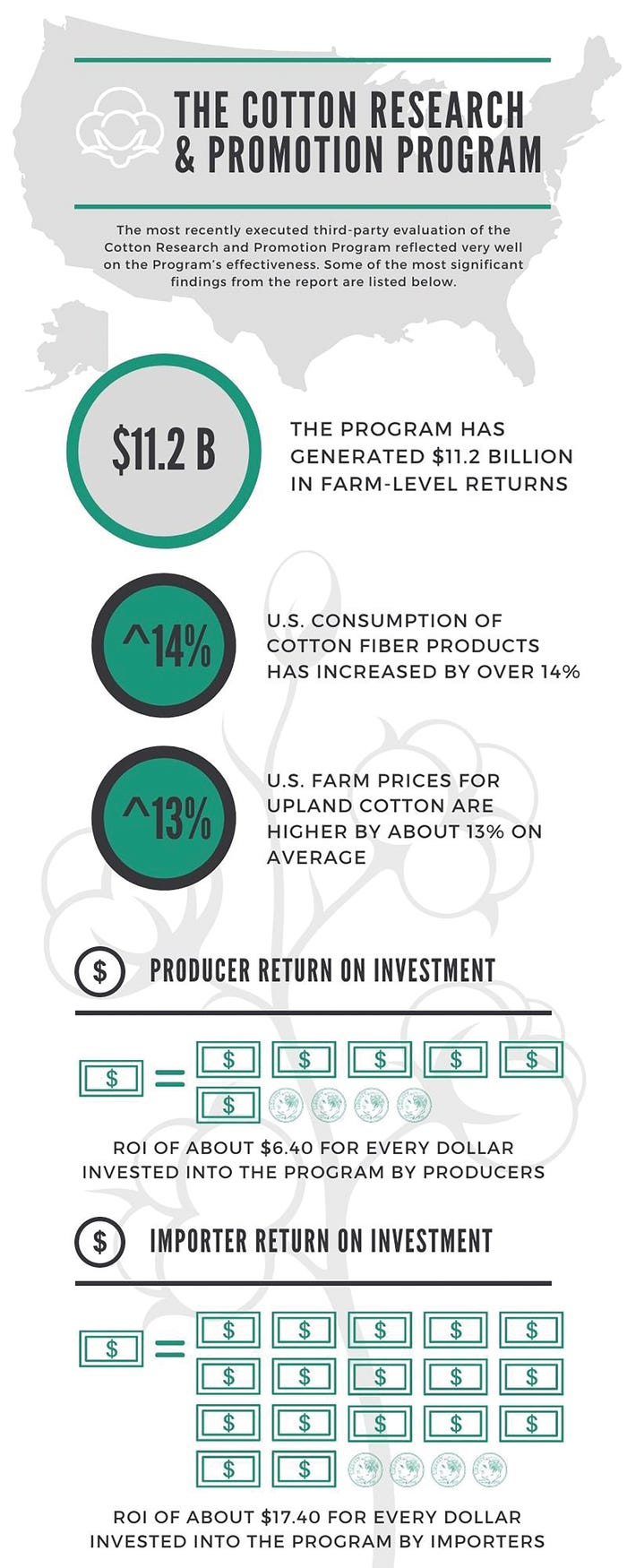
The Cotton Research and Promotion Program (the Program) has received a report card, of sorts, providing strong evidence of a remarkable return on the industry’s investment.
The report shows the Program is enhancing revenue, improving profitability for growers and importers, and helping reduce the costs of government commodity programs.
The Program has helped put money in growers’ pockets, expanded production capacity, caused consumers to buy more cotton, and even helped support the price of cottonseed.
For context, Cotton Incorporated’s budget comes from assessments collected by The Cotton Board from producer and importer stakeholders.
This “report card” comes in the form of an independent, in-depth economic analysis of the impacts of the Program, utilizing an economic simulation model of U.S. and foreign fiber markets maintained at Texas Tech University. The economists responsible for the report look at the interactions between supply and demand and price and production to analyze the impact on cotton and cotton product markets both with and without the Program.
Study focus
The study focuses on the impacts generated by Cotton Incorporated’s marketing and consumer promotion efforts, agricultural research projects, and cottonseed research and marketing projects.
Some of the long-term impacts of the program noted in the report include:
The Program increased U.S. consumption of cotton products by over 14% per year, or about 2.74 million bales annually.
The Program increased U.S. farm prices by about 13% on average and increased U.S. cotton production.
Agricultural Research efforts have enhanced cotton yields in all U.S. production regions, led to expanded cotton acreage in some regions, and generated annual savings in production costs of about $7.60 per planted acre.
The Program has led to increased cottonseed disappearance of about 266,000 short tons per year, on average, and has increased nominal cottonseed prices by an annual average of $12.23 per short ton.
Another way to quantify positive economic impacts for stakeholders is by generating a Return on Investment ratio for everyone who contributes to the Program, essentially asking the question, “are stakeholders better off as a result of the Program?”
The report provides an emphatic “yes.”
Producer investment
Every dollar invested by cotton producers in the Program over the long term has generated about $6.4 in returns, either through higher prices or lower government program costs.The story is just as positive for cotton product importers, with each assessment dollar generating about $17 in returns.
The Program has generated a total of $11.2 billion of farm level returns since 1985, accounting for almost 9% of the net revenue earned by cotton producers.The returns generated for cotton product importers since 1991, when they first entered the Program, are even stronger.
The commentary within the report is detailed and explicit in its findings, saying, “the cotton checkoff program has enhanced cotton and cottonseed demand, augmented U.S. cotton yields and production as well as cottonseed prices, generated a positive return to both cotton producers and importers, reduced the dependence of cotton producers on government farm programs, and benefited taxpayers.
Reduced costs
Additionally, due to investment in agricultural research, the checkoff program has reduced costs per acre planted of upland cotton, primarily for fertilizer, chemicals, fuel, and custom operations.”
“Farmers are the largest individual gamblers in the world. They gamble every year on the weather, on prices, on pests, and on input costs. But there is no gamble on the Cotton Research and Promotion Program,” said Bill Gillon, president and CEO of The Cotton Board.
Every dollar invested generates multiple dollars in return. “This most recent report card demonstrates that Cotton Incorporated is clearly focused on its mission, and that the Program is well worth the industry’s investment”, said Gillon.
The full report is available on the Cotton Board website (www.cottonboard.org). The Cotton Board invites you to visit our website and review this analysis and the other information we have posted there under the “Stakeholder Transparency” tab.

The Cotton Board
About the Author(s)
You May Also Like




